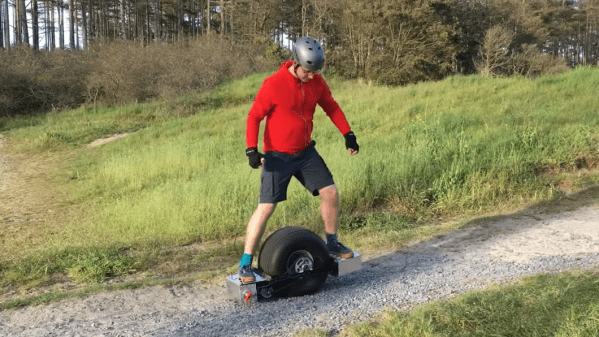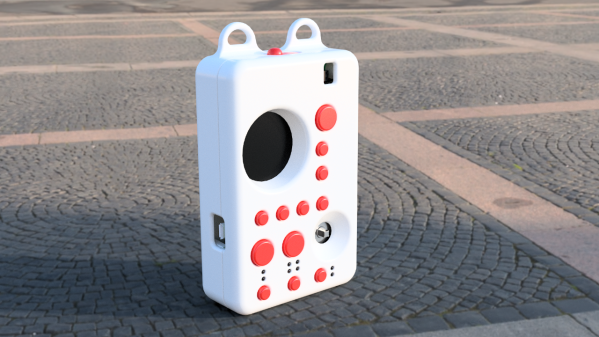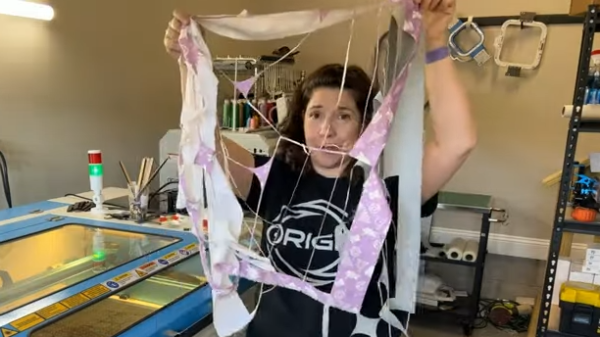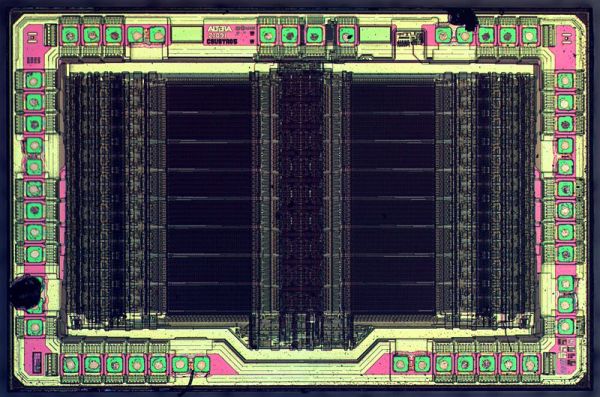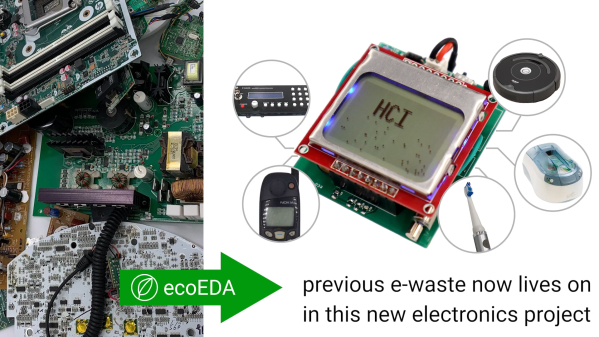We’ve previously reported from the UK about the Online Safety Bill, a piece of internet safety legislation that contains several concerning provisions relating to online privacy and encryption. UK laws enter the statutes by royal assent after being approved by Parliament, so with the signature of the King, it has now become the law of the land as the Online Safety Act 2023. Now that it’s beyond amendment, it’s time to take stock for a minute: what does it mean for internet users, both in the UK and beyond its shores? Continue reading “The UK Online Safety Bill Becomes Law, What Does It Mean?”
Behold The Mega-Wheelie, A Huge One-Wheeled Electric Skateboard
DIY electric personal vehicles are a field where even hobbyists can meaningfully innovate, and that’s demonstrated by the Mega-Wheelie, a self-balancing one-wheeled skateboard constructed as an experiment in traversing off-road conditions.
 [John Dingley] and [Nick Thatcher] have been building and testing self-balancing electric vehicles since 2008, with a beach being a common testing ground. They suspected that a larger wheel was the key to working better on rough ground and dry sand and tested this idea by creating a skateboard with a single wheel. A very big, very wide wheel, in fact.
[John Dingley] and [Nick Thatcher] have been building and testing self-balancing electric vehicles since 2008, with a beach being a common testing ground. They suspected that a larger wheel was the key to working better on rough ground and dry sand and tested this idea by creating a skateboard with a single wheel. A very big, very wide wheel, in fact.
The Mega-Wheelie houses a 24V LiFePO4 battery pack, 450 W gearmotor with chain and sprocket drive, SyRen motor controller from Dimension Engineering, Arduino microcontroller, and an inertial measurement unit to enable the self-balancing function. Steering is done by leaning, and the handheld controller is just a dead man’s switch that disables the vehicle if the person piloting it lets go.
Design-wise, a device like this has a few challenging constraints. A big wheel is essential for performance but takes up space that could otherwise be used for things like batteries. Also, the platform upon which the pilot stands needs to be as low to the ground as possible for maximum stability. Otherwise, it’s too easy to fall sideways. On the other hand, one must balance this against the need for sufficient ground clearance.

In the end, how well did it work? Well enough to warrant a future version, says [John]. We can’t wait to see what that looks like, considering their past 3000 W unicycle’s only limitation was “personal courage” and featured a slick mechanism that shifted the pilot’s weight subtly to aid steering. A video of the Mega-Wheelie (and a more recent unicycle design) is embedded just below the page break.
Continue reading “Behold The Mega-Wheelie, A Huge One-Wheeled Electric Skateboard”
Ham Radio May Speed Up Soon
The FCC is circulating a proposal for new rules pertaining to amateur radio in the United States. In particular, they want to remove certain baud rate restrictions that have been in place since 1980. It appears the relaxed rules would apply only to some bands, notably some VHF and UHF bands along with the 630 meter and 2200 meter bands, which — we think — are lightly used so far. We’ll save you from grabbing the calculator. That’s around 475 kHz and 136 kHz.
Ham radio operators have long used digital modes like radio teletype and with restrictions on antennas and increasing interference from wireless networking to solar panels and more, digital has become even more popular than in the past. Besides that, cheap computer soundcards make it easier than ever and sophisticated digital modulation techniques have long left the old, clunky TeleType in the dust.
However, the FCC currently limits the baud rate to 300 baud or less, ostensibly to restrict signal bandwidth. No one wants to have an entire band consumed by a 10 Gb RF network. However, modern techniques often squeeze more into less and the FCC will finally recognize that by converting the limit to signal bandwidth, not baud rate.
What’s the bandwidth? For the common bands, it sounds like 2.8 kHz is the answer. For the VLF bands, they are asking for suggestions. The 2200 meter band isn’t even 2.8 kHz wide to start with!
All this talk makes us want to build something for the 2200 meter band. We better start winding the coil now. Then again, maybe we should go piezo. You know, just in case Thomas Dolby tells us that one of our submarines is missing.
Packing For Supercon? Here’s A Printable Case For Your Badge
Hackaday Supercon 2023 is a week away, and if you’re still thinking about the equipment you need to take with you, here’s something you’ll want to print – a case for the Supercon 2023 badge that you will find inside of your goodie bag. This year’s Supercon badge is a gorgeous analog playground board we call Vectorscope, powered by an RP2040, MicroPython, and a ton of love for all of the creativity that we’ve seen you bunch express through the wonders of analog electronics. There’s a round LCD screen, SMD buttons galore, as well as some pokey through-hole headers, and if you’ve carried a badge around, you know that all of these can be a bit touchy! You’re in luck, though – just in time, [T.B. Trzepacz] brings us a 3D-printed shell.
Over on Hackaday Discord, we’ve been watching this shell go through multiple iterations throughout the past few days – the initial design pics appeared almost as soon as we published the PCB files for the badge! Yesterday, [T.B. Trzepacz] dropped by the Design Lab where we’ve been putting finishing touches on the badges, and armed with the real-world PCBs, made the final tweaks to the design – then gave us the go-ahead to spread the word.
This shell is practical but elegant and does a mighty fine job protecting both the badge and the wearer. Nothing is hidden away, from the buttons to the expansion headers, and the lanyard holes keep it wearable. At this time, grab the Basic 2 files – these should work for SLA and FDM printers alike, and they’re tolerant enough even for FDM printers below average. Pick your favourite color scheme, or go for one of the transparent SLA resins, and when you arrive at the Supercon, you’ll have a case you can rely on.
Want to give this case your own spin? Perhaps a Pip-Boy aesthetic or a Vectrex console vibe? Should you want to modify anything, the Fusion360 sources are right there, open-source as they ought to be. It’s been a pleasure watching this case design grow, and in case you’re looking to hire a skilled engineer in Berlin, [T.B. Trzepacz] is looking for work!
Take The Tedium Out Of Fabric Cutting, Make The Laser Do It
Fabric must be cut before it can be turned into something else, and [fiercekittenz] shows how a laser cutter can hit all the right bases to save a lot of time on the process. She demonstrates processing three layers of fabric at once on a CO2 laser cutter, cutting three bags’ worth of material in a scant 1 minute and 29 seconds.
The three layers are a PU (polyurethane) waterproof canvas, a woven liner, and a patterned cotton canvas. The laser does a fantastic job of slicing out perfectly formed pieces in no time, and its precision means minimal waste. The only gotcha is to ensure materials are safe to laser cut. For example, PU-based canvas is acceptable, but PVC-based materials are not. If you want to skip the materials discussion and watch the job, laying the fabric in the machine starts around [3:16] in the video.
[fiercekittenz] acknowledges that her large 100-watt CO2 laser cutter is great but points out that smaller or diode-based laser machines can perfectly cut fabric under the right circumstances. One may have to work in smaller batches, but it doesn’t take 100 watts to do the job. Her large machine, for example, is running at only a fraction of its full power to cut the three layers at once.
One interesting thing is that the heat of the laser somewhat seals the cut edge of the PU waterproof canvas. In the past, we’ve seen defocused lasers used to weld and seal non-woven plastics like those in face masks, a task usually performed by ultrasonic welding. The ability for a laser beam to act as both “scissors” and “glue” in these cases is pretty interesting. You can learn all about using a laser cutter instead of fabric scissors in the video embedded below.
Continue reading “Take The Tedium Out Of Fabric Cutting, Make The Laser Do It”
Using EPROMS And EEPROMs As Programmable Logic With Lisp
That EPROMs, EEPROMs and kin can be used as programmable logic should probably not come as a major surprise, but [Jimmy] has created a Lisp-based project that makes using these chips as a logic array very straightforward. All it takes is importing the package into one’s Lisp project and defining the logic, before the truth function generates the binary file that can be written to the target chip.
Suggested is the one-time-programmable AT27C512R EPROM (64k x8), but any 8-bit parallel interface (E)EPROM should work, with non-OTP chips being nice unless the chip has to go into a production device. A possible future improvement is the addition of 16-bit (E)EPROM support.
The use of EEPROMs is common with PLA-replacements, as with, for example, the Commodore 64, where the official PLA IC tends to go bad over time. Due to the complexity of the logic in these PLA ICs, here CPLDs are used, which internally are still EEPROM-based, but feature many more programmable elements to allow for more complex logic. If all you need is a bit of glue logic and you are looking for something in between a stack of 74-logic ICs and a CPLD, an EEPROM may be just be the solution, regardless of whether you prefer to create the binary image with Lisp or C.
Continue reading “Using EPROMS And EEPROMs As Programmable Logic With Lisp”
EcoEDA Integrates Your Junk Bin Into Your Designs
If you’re like us, there’s a creeping feeling that comes over you when you’re placing an order for parts for your latest project: Don’t I already have most of this stuff? With the well-stocked junk bins most of us sport and the stacks of defunct electronics that are almost always within arm’s length, chances are pretty good you do. And yet, we always seem to just click the button and place a new order anyway; it’s just easier.
But what if mining the treasure in your junk bin was easier? If you knew right at design time that you had something in your stash you could slot into your build, that would be something, right? That’s the idea behind ecoEDA, a Python-based KiCAD plugin by [Jasmine Lu], [Beza Desta], and [Joyce Passananti]. The tool integrates right into the schematic editor of KiCAD and makes suggestions for substitutions as you work. The substitutions are based on a custom library of components you have on hand, either from salvaged gear or from previous projects. The plug-in can make pin-for-pin substitutions, suggest replacements with similar specs but different pinouts, or even build up the equivalent of an integrated circuit from available discrete components. The video below gives an overview of the tool and how it integrates into the design workflow; there’s also a paper (PDF) with much more detail.
This seems like an absolutely fantastic idea. Granted, developing the library of parts inside all the stuff in a typical junk bin is likely the biggest barrier to entry for something like this, and may be too daunting for some of us. But there’s gold in all that junk, both literally and figuratively, and putting it to use instead of dumping it in a landfill just makes good financial and environmental sense. We’re already awash in e-waste, and anything we can do to make that even just a little bit better is probably worth a little extra effort. Continue reading “EcoEDA Integrates Your Junk Bin Into Your Designs”


